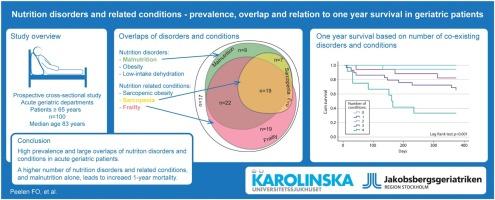Nutrition disorders and related conditions—Prevalence, overlap and relation to one year survival in geriatric patients
IF 4
3区 医学
Q1 GERIATRICS & GERONTOLOGY
引用次数: 0
Abstract
Objectives
To investigate the overlap between the nutrition disorders (malnutrition, low-intake dehydration, obesity) and nutrition related conditions (frailty, sarcopenia, sarcopenic obesity), and the significance of each of these and their combinations for survival among older patients admitted to geriatric care.
Methods
This exploratory study was based on a cross-sectional study with 100 patients (≥65 years) admitted to two geriatric departments. Data was retrieved from the Electronic Patient Record. Malnutrition was defined according to the Global Leadership Initiative on Malnutrition (GLIM) criteria with no prior screening. A low-intake dehydration equation, using proxy urea, was applied. Obesity was diagnosed at BMI > 29.9 kg/m2. Frailty was assessed by Clinical Frailty Scale, whereas sarcopenia was diagnosed according to the European Working Group of Sarcopenia in Older People (EWGSOP2). Sarcopenic obesity was defined as the combination of sarcopenia and obesity. Mortality was recorded up to one year after discharge.
Main findings
The nutrition disorders and nutrition related conditions displayed considerable overlaps, and the prevalences were; frailty 67%, low-intake dehydration 62%, malnutrition 58%, sarcopenia 30%, obesity 13%, and sarcopenic obesity 0%. Higher numbers of nutrition disorders and nutrition related conditions combined, and malnutrition (according to GLIM) alone, were related to decreased one-year survival as show in Kaplan Meier plots.
Conclusion
The prevalence and overlap of the nutrition disorders; malnutrition, and low-intake dehydration and the nutrition related conditions; frailty and sarcopenia were high in patients acutely admitted to geriatric departments. Increasing number of nutrition disorders and nutrition related conditions combined, and malnutrition alone were associated with decreased survival.

营养失调及相关疾病:老年患者的患病率、重叠及与一年生存率的关系
目的探讨营养失调(营养不良、低摄入量脱水、肥胖)和营养相关疾病(虚弱、肌肉减少症、肌肉减少性肥胖)之间的重叠,以及这些疾病及其组合对老年患者生存的意义。方法本探索性研究基于一项横断面研究,纳入了两个老年科收治的100例患者(≥65岁)。数据从电子病历中检索。营养不良是根据全球营养不良领导倡议(GLIM)标准定义的,没有事先筛查。采用替代尿素的低进食量脱水方程。BMI >; 29.9 kg/m2诊断为肥胖。虚弱是通过临床虚弱量表评估的,而肌肉减少症是根据欧洲老年人肌肉减少症工作组(EWGSOP2)诊断的。肌少性肥胖被定义为肌少症和肥胖的结合。出院后一年的死亡率均有记录。主要发现:营养失调与营养相关疾病存在一定的重叠,患病率为:虚弱67%,低摄入量脱水62%,营养不良58%,肌肉减少30%,肥胖13%,肌肉减少型肥胖0%。Kaplan Meier图显示,较高数量的营养失调和营养相关疾病,以及单独的营养不良(根据GLIM),与一年生存率下降有关。结论营养失调的患病率和重叠性;营养不良、低摄入量脱水及与营养有关的情况;老年急诊科患者虚弱和肌肉减少率较高。营养失调和营养相关疾病的数量增加,以及单独的营养不良与生存率下降有关。
本文章由计算机程序翻译,如有差异,请以英文原文为准。
求助全文
约1分钟内获得全文
求助全文
来源期刊
CiteScore
7.80
自引率
3.40%
发文量
136
审稿时长
4-8 weeks
期刊介绍:
There is increasing scientific and clinical interest in the interactions of nutrition and health as part of the aging process. This interest is due to the important role that nutrition plays throughout the life span. This role affects the growth and development of the body during childhood, affects the risk of acute and chronic diseases, the maintenance of physiological processes and the biological process of aging. A major aim of "The Journal of Nutrition, Health & Aging" is to contribute to the improvement of knowledge regarding the relationships between nutrition and the aging process from birth to old age.

 求助内容:
求助内容: 应助结果提醒方式:
应助结果提醒方式:


